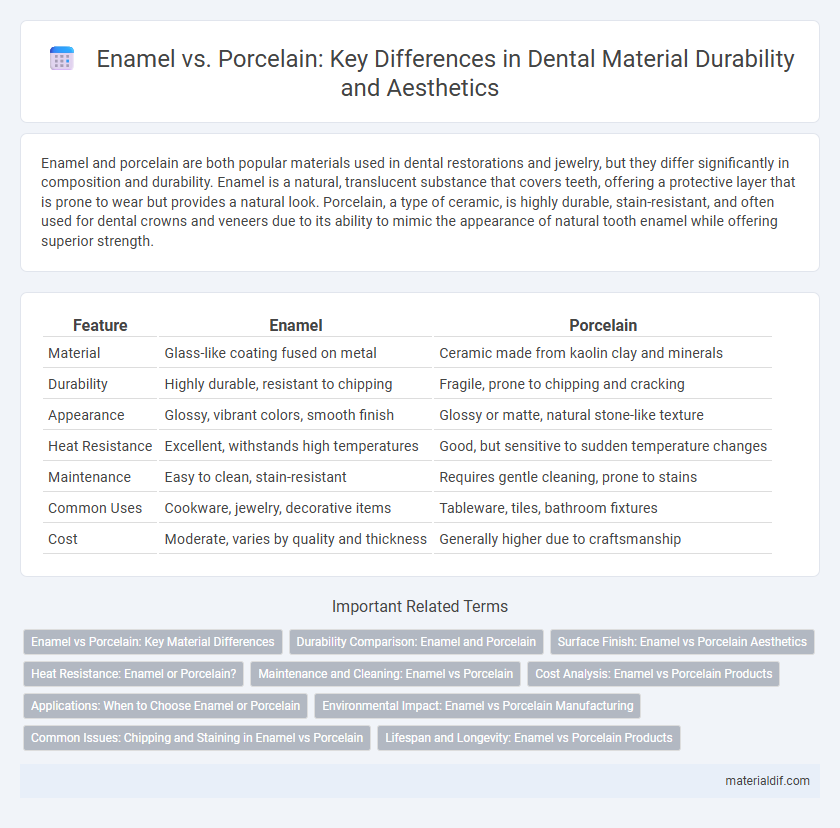Enamel and porcelain are both popular materials used in dental restorations and jewelry, but they differ significantly in composition and durability. Enamel is a natural, translucent substance that covers teeth, offering a protective layer that is prone to wear but provides a natural look. Porcelain, a type of ceramic, is highly durable, stain-resistant, and often used for dental crowns and veneers due to its ability to mimic the appearance of natural tooth enamel while offering superior strength.
Table of Comparison
| Feature | Enamel | Porcelain |
|---|---|---|
| Material | Glass-like coating fused on metal | Ceramic made from kaolin clay and minerals |
| Durability | Highly durable, resistant to chipping | Fragile, prone to chipping and cracking |
| Appearance | Glossy, vibrant colors, smooth finish | Glossy or matte, natural stone-like texture |
| Heat Resistance | Excellent, withstands high temperatures | Good, but sensitive to sudden temperature changes |
| Maintenance | Easy to clean, stain-resistant | Requires gentle cleaning, prone to stains |
| Common Uses | Cookware, jewelry, decorative items | Tableware, tiles, bathroom fixtures |
| Cost | Moderate, varies by quality and thickness | Generally higher due to craftsmanship |
Enamel vs Porcelain: Key Material Differences
Enamel is a glassy, protective coating fused to metal or ceramics at high temperatures, known for its durability and smooth finish, while porcelain is a ceramic material fired at even higher temperatures, noted for its strength and translucency. Enamel typically has a more vibrant, glossy surface and resists chipping, whereas porcelain offers higher hardness and resistance to thermal shock but can be more brittle. The key material difference lies in enamel's vitreous coating versus porcelain's solid ceramic composition, impacting their applications in jewelry, cookware, and dental restorations.
Durability Comparison: Enamel and Porcelain
Enamel offers superior resistance to chipping and cracking compared to porcelain due to its metal base, making it more durable under heavy use. Porcelain, while aesthetically pleasing, is more brittle and prone to fractures with impact, reducing its lifespan in high-traffic environments. Enamel surfaces can also better withstand thermal shock and abrasion, enhancing their durability over time relative to porcelain.
Surface Finish: Enamel vs Porcelain Aesthetics
Enamel offers a smooth, glossy surface finish that enhances durability and resists staining, creating a vibrant appearance over time. Porcelain provides a natural, matte or semi-gloss finish that mimics the texture of natural teeth or ceramics, delivering superior aesthetics in dental and decorative applications. The choice between enamel and porcelain surfaces depends on the desired balance between high-gloss resistance and authentic visual texture.
Heat Resistance: Enamel or Porcelain?
Enamel offers superior heat resistance compared to porcelain, withstanding temperatures up to 1,200degF (650degC) without cracking or discoloration. Porcelain, while durable, is more susceptible to thermal shock and can fracture under sudden temperature changes, typically tolerating heat up to 1,100degF (593degC). This makes enamel the preferred choice for applications involving direct high-heat exposure, such as cookware and industrial coatings.
Maintenance and Cleaning: Enamel vs Porcelain
Enamel surfaces require gentle cleaning with non-abrasive materials to maintain their smooth finish and prevent chipping, while porcelain demands careful handling to avoid cracks due to its brittler nature. Both materials resist staining, but porcelain is more resistant to harsh chemicals, making it suitable for areas exposed to frequent cleaning agents. Proper maintenance of enamel involves regular sealing to protect against wear, whereas porcelain benefits from periodic glaze touches to maintain its appearance.
Cost Analysis: Enamel vs Porcelain Products
Enamel products generally offer a lower cost compared to porcelain due to less expensive raw materials and simpler manufacturing processes. Porcelain items, while pricier, provide greater durability and a more refined finish, justifying their higher investment in premium applications. Cost analysis reveals enamel is ideal for budget-conscious projects, whereas porcelain suits premium designs demanding long-term resilience.
Applications: When to Choose Enamel or Porcelain
Enamel is ideal for cookware and decorative surfaces due to its durability, heat resistance, and vibrant color options, making it suitable for kitchen appliances and art pieces. Porcelain is preferred in bathroom fixtures, tiles, and fine dishware because of its smooth, non-porous surface and elegant finish, offering superior stain resistance and easy maintenance. Choose enamel for high-impact, heat-exposed applications and porcelain for aesthetic, hygienic, or moisture-prone environments.
Environmental Impact: Enamel vs Porcelain Manufacturing
Enamel manufacturing typically involves lower energy consumption and fewer harmful emissions compared to porcelain production, which requires high-temperature kiln firing processes that release significant CO2 and other pollutants. Porcelain relies heavily on kaolin clay and feldspar, whose extraction can cause considerable environmental degradation and habitat disruption. Enamel's use of recycled glass and metal substrates often results in a smaller carbon footprint, making it a more environmentally sustainable choice in manufacturing.
Common Issues: Chipping and Staining in Enamel vs Porcelain
Enamel and porcelain both face chipping and staining, but enamel is more prone to gradual wear and surface discoloration due to its organic composition, making it susceptible to acidic foods and beverages. Porcelain, being harder and more durable, resists chipping better but can develop surface cracks and stain if the glaze wears down over time. Proper maintenance and avoiding abrasive cleaning methods are critical to prolonging the lifespan and aesthetic quality of both materials.
Lifespan and Longevity: Enamel vs Porcelain Products
Enamel products typically offer a lifespan of 10 to 20 years, known for their durability and resistance to stains and scratches, while porcelain products can last 30 years or more due to their hardness and resistance to chipping. Porcelain's denser composition makes it less prone to wear over time, making it ideal for long-term applications such as dental restorations or kitchen surfaces. Enamel, though durable, may require more frequent maintenance and touch-ups compared to porcelain's enduring finish.
Enamel vs Porcelain Infographic

 materialdif.com
materialdif.com